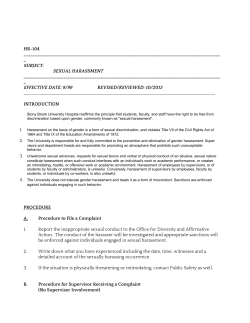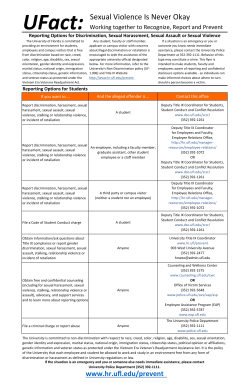
Title IX Training Content Checklist 8.5x14 Front
Title IX/SaVE Act Prevention & Training Checklist = Required explicitly by OCR and/or DOJ in the April 4, 2011 DCL and/or in other + major Resolution Agreements and letters (e.g.: U. of Montana, Yale, Xavier, Eastern Michigan, Notre Dame College) = Either implied as necessary elements in various OCR Resolution Agreements, and/or recommended by ATIXA HOW WHO ◆ = Required by Campus SaVE Act (2013 VAWA Reauthorization) LEVEL A Title IX Compliance Officers LEVEL B Mostly First Responders LEVEL C Responsible Employees Title IX Coordinator, Investigators, Hearing Boards (including appeals), others involved in processing, investigating, or resolving complaints or those who assist in coordination (deputies) Resident assistants, Health Center employees, Counselors, Sexual assault response coordinators, Academic Advisors, Police/Public Safety Any employee who has the authority to take action to redress harassment, OR has the duty to report harassment to appropriate officials, OR is someone a student could reasonably believe has this authority or responsibility In person Online Orientation + ◆ Mandatory WHEN + + + Annually (as job-appropriate) + LEVEL D Faculty & Staff All Students All Faculty & Staff + ◆ (annually) ◆ + + (During Orientation) + ( Xavier) (as job-appropriate) ◆ LEVEL E Students (including campers, potentially) ◆ (”ongoing”) (annually) ◆ (”ongoing”) Class Registration for returning students (annually) Residence Life Orientation for on-campus students (annually) Student-athlete Orientation: Student-athletes & coaches (annually); refresher for current athletes and coaches (ATIXA recommends annual refresher WHAT Re-training Annually (covering at least updates in law and policy) (ATIXA recommends annually) Annually (covering at least updates in law and policy) Annually (covering at least updates in law and policy) OCR letters cite “annual training; update”training); Campus SaVE indicates “ongoing” Every 3 years (Montana); Campus SaVE indicates “ongoing” Oversight and Resources University’s Title IV and Title IX responsibilities to address allegations of sexual harassment ◆ Role of Federal government in enforcing Title IX and DOJ’s role with Title IV + + + + Overview of rights Title IX and Title IV confer on students and/or employees + + + Institutional policies regarding sexual misconduct ◆ + When university exercises off-campus jurisdiction + + + + How complainants can invoke the Title IX complaint and grievance procedure(s) (student conduct, employee, etc.) + + + What is sex harassment and sex discrimination (using clear examples)? + + + + + Recognizing what constitutes a Title IX or Title IV allegation or complaint + + + + + Resources available to those who have experienced sexual harassment/ discrimination (including retaliation) Identifying and Reporting Sexual Harassment How to contact the Title IX Coordinator How and to whom to report sex-based harassment First responder’s responsibility to facilitate filing of complaints How to notify complainant of right to file and how to file a criminal complaint Responding to Title IX and Title IV allegations and complaints Procedures for victims when a sex offense, dating violence, domestic violence, sexual assault or stalking has occurred, including: 1) the importance of preserving evidence, 2) to whom to report such alleged offenses, 3) victims’ options to notify law enforcement and campus authorities Providing fair and objective communication that does not discourage complainants from reporting + ◆ ◆ ◆ Policies and procedures for accepting and processing Title IX complaints Definitions of Consent (in reference to sexual activity), Domestic Violence, Dating Violence, and Stalking in applicable jurisdiction ◆ + ◆ + Prevention ◆ (Primary Required) + (Primary Prevention Recommended) + (Primary Prevention Recommended) ◆ (Primary Prevention Required) ◆ (Primary Prevention Required) Institutional policies and prohibitions pertaining to Sexual Assault, Domestic Violence, Dating Violence and Stalking ◆ + + ◆ ◆ Criminal, academic, housing, athletic, and student-record-related consequences of committing a Title IX violation + + + + www.atixa.org ©ATIXA 2O13. All rights reserved. Title IX/SaVE Act Prevention & Training Checklist (cont.) WHAT LEVEL A Title IX Compliance Officers LEVEL E Students (including campers, potentially) LEVEL B Mostly First Responders LEVEL C Responsible Employees LEVEL D Faculty & Staff + + + + + + Investigating, Responding to and Rendering Findings on Complaints Appropriate interaction with complainants How to conduct and document adequate, prompt, reliable & impartial investigations How to conduct an investigation and hearing process that protects the safety of complainants and promotes accountability ◆ Differences between criminal and Title IX investigations Appropriate information sharing with campus partners Consequences of lying during an investigation + + + + Coordinating and cooperating with law enforcement (campus and local) during parallel criminal and Title IX proceedings How to encourage victims and witnesses to cooperate with investigations when they are concerned about conduct or disciplinary implications of alcohol or drug use How to provide students with information both verbally and through resource guides when responding to complaints Rights of complainant and respondent during investigations, hearing and appeal including informing trainees: That complainant and respondent have the same opportunities to have others present during any meeting or disciplinary proceeding That the complainant and respondent will be simultaneously informed in writing of the outcome of any institutional disciplinary proceeding that arises from an allegation of domestic violence, dating violence, stalking, sexual assault Of procedures for complainant and respondent to appeal That complainant and respondent will be notified of any change in the results that occurs prior to when such results become final That complainant and respondent will be notified when results become final How to address link of alcohol and drugs and sex-based harassment in investigations + (discussion of immunity policies) + + + (discussion of immunity policies) + (discussion of immunity policies) + + + + ◆ ◆ + + ◆ ◆ + + ◆ ◆ + + ◆ ◆ + + ◆ ◆ + + ◆ ◆ Remedies Possible sanctions and protective measures an institution may impose following an institutional disciplinary procedure involving rape, acquaintance rape, domestic violence, dating violence, sexual assault or stalking Describe victims’ rights and institutional responsibilities regarding orders of protection, no contact orders, restraining orders, or similar lawful orders Describe and detail prompt, fair and impartial institutional disciplinary procedures to address allegations of domestic violence, dating violence, sexual assault, stalking; emphasize that procedures protect safety of victims and promote accountability Provide information about how the institution protects the confidentiality of the complainant including when working with publicly-available documents Notify victims about existing counseling, health, mental health, victim advocacy, legal assistance and other on- and offcampus resources for complainants Notify about complainant’s options for assistance in changing academic, living, transportation and working situations (upon request of complainant and subject to reasonable availability of such accommodations); note that such accommodations are available regardless of whether complainant files a report with police + + + ◆ ◆ + + + ◆ ◆ + + + ◆ ◆ + + + ◆ ◆ + + + ◆ ◆ + + + ◆ ◆ Consent, Substance Abuse and Bystanders The link between alcohol and drug use and sex-based harassment Consent in sexual interactions (including the role of alcohol and other drugs and State definitions of consent) (Primary Prevention Recommended) Prevention + (Primary Recommended) Prevention + (Primary Recommended) Prevention + (Primary Recommended) + (Primary Prevention Recommended) + (Primary Prevention Recommended) (Primary Prevention Recommended) + (Primary Prevention Recommended) + (Primary Prevention Recommended) (Primary Prevention Recommended) Information on risk reduction - recognizing warning signs of abuse, how to avoid potential attacks Role of bystanders and safe and positive options for bystander intervention that may be carried out by an individual to prevent harm or intervene when there is a risk of domestic violence, dating violence, sexual assault or stalking ◆ Prevention + (Primary Required) + (Primary Prevention Recommended) Prevention + (Primary Recommended) ◆ (Primary Prevention Required) ◆ ◆ (Primary Prevention Required) Assessment Written assessment that demonstrates what training participants learned Survey to assess knowledge and demonstrate what participants learned System recording identifier of each person who completed training + + www.atixa.org ©ATIXA 2O13. All rights reserved. + + + + +
© Copyright 2025





















